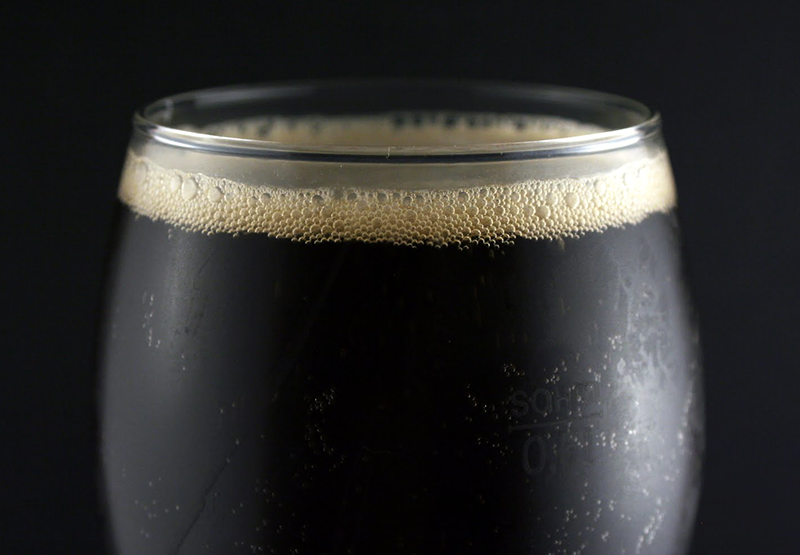 It’s been just over three weeks since I bottled my black lager (a.k.a. schwarzbier). Though I’m generally happy with the beer recipe I used, my tasting notes have caused me to take a closer look at my all-grain brewing procedures and my methods of water chemistry adjustment (it’s a work in progress!).
It’s been just over three weeks since I bottled my black lager (a.k.a. schwarzbier). Though I’m generally happy with the beer recipe I used, my tasting notes have caused me to take a closer look at my all-grain brewing procedures and my methods of water chemistry adjustment (it’s a work in progress!).
First, let’s look at the tasting notes from evaluating this black lager beer:
- Aroma: bready, with note of chocolate, dark fruit, and lager yeast
- Appearance: dark brown with a tan head, brilliant clarity
- Flavor: malt-forward and dry with a carbonic bite and some hop bitterness
- Mouthfeel: medium-light bodied with prickly carbonation
- Overall: solid recipe, no fermentation faults, but mineral content seems strong
So what do I mean by that “carbonic bite” and “mineral content seems strong”? It’s a little hard to explain, but I’ll do my best.
Carbonated soft drinks contain obscene amounts of sugar – one 12-oz. can has the equivalent of 40 packets of sugar. Part of the reason that sodas don’t taste as sweet as they are is the carbonation. The dissolved carbon dioxide reacts to create carbonic acid, which balances out some of the sweetness. What I taste is similar to the dry, slightly acidic sensation you get when drinking soda.
The reason I’m pretty sure that what I taste comes from carbonate comes from my brewing notes. Looking back over my brew day, I recall that I added 14 grams of chalk to my water in an attempt to mimic the hard water of Munich. In retrospect, 14 grams seems like a lot. What I failed to realize is that brewers in Munich often decarbonated the water before brewing with it.
What is Decarbonation?
 Decarbonation simply reduces the amount of carbonate in water. To decarbonate brewing water, brewers in Munich (and other areas with hard water) would boil their brewing water, which caused the chalk to come out of solution and settle to the bottom of the brew kettle. Then the decarbonated water could be removed for brewing. (You can read more about decarbonation here.)
Decarbonation simply reduces the amount of carbonate in water. To decarbonate brewing water, brewers in Munich (and other areas with hard water) would boil their brewing water, which caused the chalk to come out of solution and settle to the bottom of the brew kettle. Then the decarbonated water could be removed for brewing. (You can read more about decarbonation here.)
It seems that brewers in Munich often decarbonated their water when brewing lighter colored beers, like Maibock or Munich Helles, but it’s unclear whether or not they traditionally decarbonated their water when brewing schwarzbier (if you have this information, I’d love to see it!).
So based on what I’ve discovered and the tasting notes from evaluating this black lager beer, what would I do next time around to make this it better?
First, I’d cut that chalk addition in half, maybe targeting a more balanced water profile than what I used. I think in general, homebrewers should take care not to go overboard with water additions. Also, I wouldn’t mind a little more sweet, bready character in the beer. Either using more Munich malt or increasing the mash temperature could help with this.
Have you ever brewed a black lager? What advice do you have about water amendments?
The Rest of This Story:
Preparing for a Black Lager Brew Day
Black Lager Brewday: Double Infusion Mash
Bottling My Black Lager Beer
———————————–
David Ackley is a writer, brewer, and craft beer marketing consultant. He holds a General Certificate in Brewing from the Institute of Brewing and Distilling and is founder of the Local Beer Blog.

Hi
Been brewing for 7years and I think you are confusing 2 issues.
Rightly stated, the “carbonic bite” is from desovled carbondioxide that reacts to give small amounts of carbonic acid. Same as soda water. It has nothing to do with chemical additions.
Carbonate, CO3, adds to the hardness or alkalinity of your water that infuences your pH. It is not involved in the formation of carbonic acid and carbonic bite. In the book Water, published by AHA, they advise against using chalk, CaCO3, as an addition because very little actually desolves when added and it has very little effect on the water chemistry.
Cheers